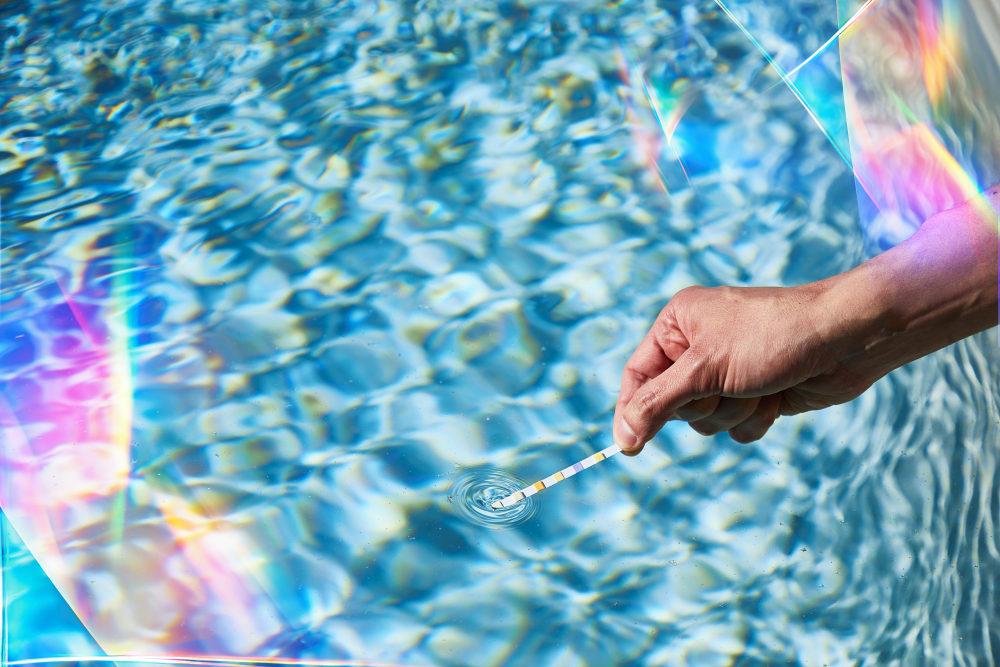Taylor Test Strips take the guesswork out of water care, making it easy to monitor water quality with straightforward instructions. Whether you're new to pool maintenance or need a refresher, understanding the right technique is key to getting accurate readings. Here's a step-by-step guide on how to use test strips effectively for accurate, reliable results every time.
How to Test: A Step-by-Step Guide
Remove one strip from the bottle, grasping it by the non‑reactive end, and immerse the reactive pads for no more than a few seconds. The brief exposure is intentional; prolonged contact can oversaturate the pads and obscure color differentiation. Then, dip the strip directly into the pool water at a wrist-deep level, avoiding areas near return jets, skimmers, or chemical feeders. This helps ensure you’re testing a representative sample. If preferred, you can also collect water from the same depth using a clean plastic cup or tube and perform the test away from the pool. Hold the strip horizontally immediately after removal to prevent the solution from migrating between pads, then allow twenty seconds for color development.
Compare the developed strip with the color chart printed on the bottle in natural daylight or under neutral white lighting. Position the strip adjacent to the chart rather than directly on top so light reflects evenly from both surfaces. For the clearest match, slowly move the strip side to side along the chart to compare each pad to its corresponding color block. Read each pad within thirty seconds to avoid drift, then record the values in a logbook or digital application before adjusting sanitizer, pH, total alkalinity, or other parameters as needed.
Best Practices for Consistent, Accurate Measurements
Reliable testing depends on consistent technique and proper strip care. Store test strips tightly capped in a dry location; excessive temperature or humidity degrades reagent performance and can dull color transitions. Rinse and dry hands before handling strips to prevent contamination from sunscreen, lotions, or chemical dust. Establish a routine testing schedule—such as twice weekly in the morning—to minimize variability introduced by sunlight, bather load, or overnight chemical demand. Verify the expiration date printed on the bottle prior to testing. Reagent pads lose sensitivity over time, and outdated strips can produce misleading results even if they change color upon completing a test.
Dos and Don'ts
For the most accurate results, dip the strip at wrist depth. This helps to avoid the top layer of water, which often contains oils and debris that can affect readings. Be sure to read the strip in natural sunlight or bright, neutral lighting for the clearest color match. Once finished, discard the strip after a single use.
Avoid skimming just the surface of the water, as this can lead to inaccurate pH and sanitizer readings. Don’t touch or rub the pads—this can smudge or remove the reactive chemicals. Also, try not to read the strip under artificial light, as it can distort how you see the colors. And finally, never reuse a strip—once the pads are activated, they continue to change, and re-dipping won’t provide reliable results.
Why Choose Taylor Test Strips
Taylor has specialized in water analysis for nearly a century, serving residential pool and spa owners, service professionals, and commercial operators. Our test strips exemplify three core strengths:
Precision through Integrated Manufacturing
Every Taylor strip is formulated, produced, and quality-controlled at our Maryland headquarters, ensuring that the strips coincide with the color blocks on each bottle. This alignment produces clear, repeatable color transitions that reduce interpretation errors.
Expertise Rooted in Science
Our team of chemists develops all of our trusted water testing solutions—including pool and spa test kits and strips—that are used in homes, businesses, and even industrial settings. From the formulation of the reagents to the layout of the testing tools, every detail is crafted with care to deliver accurate results in a format that’s simple to use, whether you’re a seasoned pro or just getting started.
Practical Options for Diverse Maintenance Needs
Whether you're quickly checking chlorine and pH levels before a weekend gathering or performing a more comprehensive multi‑parameter scan, Taylor offers test strips tailored to your needs. The popular 7‑Way Test Strips measure free chlorine, total chlorine (or bromine), pH, total alkalinity, calcium hardness, and stabilizer—all in a single dip. For pool service professionals, our Service Pro™ Test Strips offer fast, reliable readings for free chlorine, total chlorine/bromine, pH, and alkalinity—ideal for efficient route work. Every bottle features a soft‑touch cap for easy opening with wet hands and high‑contrast graphics for accurate, at-a-glance readings.
A Simple Path to Balanced Water
Using pool test strips properly streamlines routine maintenance and monitors water quality. By following a precise dipping technique, observing recommended development times, and adhering to best practices in storage and handling, you can trust each reading and respond promptly to any imbalance. Taylor Test Strips combine rigorous scientific design with everyday practicality, empowering pool and spa owners to maintain clear, comfortable water confidently.
Visit our pool and spa test strips collection to select the strip that aligns with your maintenance goals and keep your water at its best all season long.

